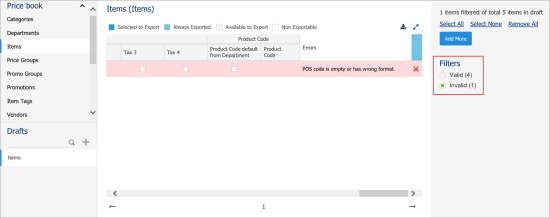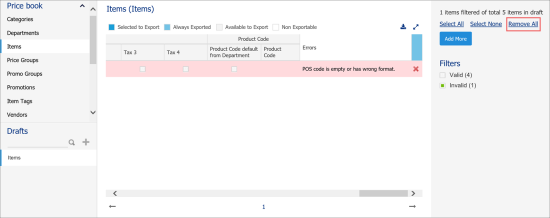When you import data from files to the buffer or work with the draft in the Import Tool, the Import Tool validates if the objects data is correct. The validation process helps identify the objects that are set up incorrectly or do not comply with the Price Book rules. For example, the SKU type for some item can be specified in the wrong format, the Name field for some category can be empty and so on.
The Import Tool groups all invalid objects and lets you review them as a single list. For each invalid object, the Import Tool provides a detailed description of the problem. You can review invalid objects, correct the problems and then save the objects to the destination location. As a result, you can be sure that only correct Price Book data is imported to the system.
The Import Tool does not export invalid objects data to destination locations.
Validation for promotions, item tags and vendors will be implemented in a future release.
To work with invalid objects in the Import Tool, you can perform the following activities:
Validation Rules
In the Import Tool, objects are validated by the following rules:
The Import Tool treats a category as invalid if the following errors are encountered:
| Validation Condition | Error Description |
|---|---|
| Number field is empty or its value has the wrong format. | Category Number is empty or has wrong format. |
| Number field value is not unique. | Category Number is not unique. |
| Name field is empty. | Category Name is empty. |
The Import Tool treats a department as invalid if the following errors are encountered:
| Validation Condition | Error Description |
|---|---|
| Number field is empty or its value has the wrong format. | Department Number is empty or has wrong format. |
| Number field value is not unique. | Department Number is not unique. |
| Name field is empty. | Department Name is empty. |
The Import Tool treats an item as invalid if the following errors are encountered:
| Validation Condition | Error Description |
|---|---|
| Name and CR Name fields are empty at the same time. | Name or CR Name is empty. |
| Name or CR Name field contains the “unknown” text. | Name contains “unknown” text. |
| POS Code is empty or its value has the wrong format: - Invalid field format (invalid symbols) - Invalid length (doesn’t correspond to the SKU type) - Invalid check-digit - Empty field value |
POS code is empty or has wrong format. |
| POS Code value is not unique. | POS code is not unique. |
| SKU type has the wrong format (contains a value other than 0, 1, 2, 3, 4 or 5). | Invalid POS code type. |
| SKU Code is not unique. | SKU code is not unique. |
The Import Tool treats a price group as invalid if the following errors are encountered:
| Validation Condition | Error Description |
|---|---|
| Number field is empty or its value has the wrong format. | Price Group Number is empty or has wrong format. |
| Number field value is not unique. | Price Group Number is not unique. |
The Import Tool treats a promo group as invalid if the following errors are encountered:
| Validation Condition | Error Description |
|---|---|
| Number field is empty or its value has the wrong format. | Promo Group Number is empty or has wrong format. |
| Number field value is not unique. | Promo Group Number is not unique. |
| Name field is empty. | Promo Group Name is empty. |
Reviewing and Fixing Invalid Data
After you add objects to the Import Tool, the Import Tool automatically launches the validation process and divides all objects into two groups:
- Valid: objects for which all data is set up correctly.
- Invalid: objects that do not comply with the Price Book rules.
To review and fix invalid data for Price Book objects, follow the steps:
- Go to Price Book > Import Tool > Price book > necessary objects module.
- Select an existing draft or create a new draft. For more details, see Working with Drafts List.
- Add the necessary objects to the draft. For more details, see Setting Up Price Book.
- In the filter in the right pane of the module, select the Invalid option.
Result: The Import Tool displays only those objects that have some problems in their data. The invalid objects are marked red. - In the Errors column, review the problem description and fix the problem if possible.
Result: The Import Tool automatically re-validates the objects and, if the problem is fixed, moves the objects to the list of valid objects. - Proceed with the import process in a regular manner.
All items with the Invalid POS Code error are marked as Invalid. You cannot update the item's code manually. To upload these items to the system, you need to correct the code value in the file and upload it again.
Removing Invalid Objects
You can remove several or all invalid objects at once. To do this, follow the steps:
- Go to Price Book > Import Tool > Price book > necessary objects module.
- Select an existing draft or create a new draft. For more details, see Working with Drafts List.
- Add the necessary objects to the draft. For more details, see Setting Up Price Book.
- In the filter in the right pane of the module, select the Invalid option.
Result: The Import Tool displays only those objects have some problems in their data. - In the objects list, select the check boxes next to the objects that you want to remove.
- At the top of the right module, click the Remove All link.
Exporting Invalid Objects Data to a File
You can export objects data to a file. For example, you can select all invalid items and export their data to a file for further analysis.
To export objects data to a file, follow the steps:
- Go to Price Book > Import Tool > Price book > necessary objects module.
- Select an existing draft or create a new draft. For more details, see Working with Drafts List.
- Add the necessary objects to the draft. For more details, see Setting Up Price Book.
- In the filter in the right pane of the module, select the Invalid option.
Result: The Import Tool displays only those objects have some problems in their data. - In the objects list, select the check boxes next to the objects whose data you want to export.
- At the top right corner of the objects list, click the export icon.





